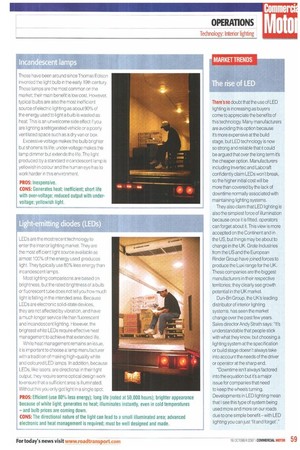. diodes (LEDs ...
Page 59

If you've noticed an error in this article please click here to report it so we can fix it.
LEDs are the most recent technology to enter the interior lighting market. They are the most efficient light source available as almost 100% of the energy used produces light. They typically use 80% less energy than incandescent lamps.
Most lighting comparisons are based on brightness, but the rated brightness Oa bulb or fluorescent tube does not tell you how much light is falling in the intended area. Because LEDs are electronic solid-state devices, they are not affected by vibration, and have a much longer service life than fluorescent and incandescent lighting. However, the brightest white LEDs require effective heat management to achieve that extended life.
While heat management remains an issue, it is important to choose a lamp manufacturer with a tradition of making high-quality white and coloured LED lamps. In addition, because LEDs, like lasers, are directional in their light output, they require some optical design work to ensure that a sufficient area is illuminated. Without this you only get light in a single spot.
PROS: Efficient (use 80% less energy); long life (rated at 50,000 hours); brighter appearance because of white light; generates no heat; illuminates instantly, even in cold temperatures — and bulb prices are coming down.
CONS: The directional nature of the light can lead to a small illuminated area; advanced electronic and heat management is required; must be well designed and made.






























































































































































































